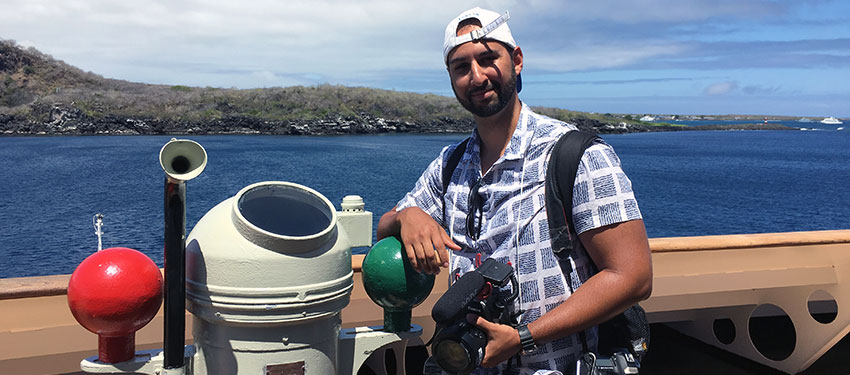A few days after arriving in the Galápagos Islands to lead his summer study-abroad course, School of Communication Professor Joseph B. Treaster dropped by the office of the Galápagos National Park and Galápagos Marine Reserve, hoping to catch the interim director at his desk.
Instead, the former New York Times reporter and foreign correspondent caught a whiff of a breaking news story and, with old-fashioned shoe-leather reporting, nailed it down: Africa Berdonces, an energetic young woman who rides a beat-up bicycle and often wears flip-flops, was about to take charge of managing the Galápagos Islands, one of the world’s environmental treasures.
Within 48 hours, Treaster’s story about Berdonces, complete with photographs of her, a blue-footed booby, and other iconic Galápagos animals taken by UM technical specialist Thomas Rodriguez, appeared in The Times, providing a real-life learning experience for the eight UM students who had come to the Galápagos to sharpen their critical thinking and writing skills by communing with nature.
During the three-week, six-credit course, “The Galápagos Islands: Environment and Culture, Writing, Research, Critical Thinking,” the students swim with sea lions and penguins, hike volcanoes, get within inches of giant Galápagos tortoises, and study Charles Darwin and climate change—all as a precursor to writing articles on Galápagos issues that will be published in the Miami Planet, the University’s online environmental magazine.
“We’re using the Times article as a model for the work the students are doing and to show them how reporters conduct interviews, seize opportunities, and turn their reporting into articles,’’ Treaster said.
That’s something Treaster knows inside out. He often draws on his 30-plus years of experience at The New York Times to inform his UM classes on the fundamentals of reporting and writing for mass audiences. And it was two of those fundamentals—keen observations and an inquisitive nature—that tipped Treaster to Berdonces’ appointment, which the Ecuadorean government had not planned to announce for a few days.
Waiting near the director’s office late that Friday afternoon of May 20, Treaster said he “sensed excitement among the secretaries and other staff assistants,” and started asking questions. Pretty soon, someone mentioned Berdonces’ news. Nobody, however, would officially confirm her appointment, so Treaster set out to find out as much as he could about her and what her new role might mean for the Galápagos.
As luck would have it, he bumped into Berdonces at the park headquarters and learned that she grew up in the Galápagos, has a master’s degree in environmental studies from James Cook University in Australia, and felt quite prepared to take on one of the world’s most significant environmental posts. “This is my passion,” she told Treaster. “I studied for this. I’ve been a national park guide. I’m a dive master. I’m from a family in the tourism business. I know the business of the Galápagos from inside.”
Within a couple hours, Treaster interviewed half a dozen other people, including Berdonces’ father, a dive shop owner, and a physician who has known her since she was a teenager.
Working with government officials and others, Treaster put Berdonces’ appointment and the challenges she faces in context. As he noted in the Times article, she is taking charge just as the Ecuadorean government is taking steps to better protect the Galápagos.
“It is,” Treaster wrote, “banning all fishing in the northern third of the island chain and creating a sanctuary for sharks. A new port on the mainland will be the exclusive conduit for cargo bound for the islands, the better to keep nonnative animals and plants from reaching the islands and disturbing the ecological balance. The government has also imposed a 36-room limit on new hotels to limit crowds, and is bringing together the management of land and sea areas, which had been overseen separately.”
As fellow instructor Heidi Carr, a former Miami Herald editor who co-directs the Galápagos program and teaches “The Galapagos Islands: Social Media and Global Strategic Communication,” noted, Treaster is a never-ending fount of such information because he never stops collecting it.
“He is continually talking to strangers and asking questions,” Carr wrote in an email from the Galápagos. “Just last night, all we wanted to do was grab dinner and buy water. He ended up interviewing the hostess of the restaurant, getting a tour of the hotel’s $380 rooms, interviewing the owner, and having a very in-depth discussion about the environment, ecology, the Galápagos government, getting permits, and what people who stay there do when they are there.”
While Treaster has had innumerable bylines in The Times over the decades and will have many more (he’ll be returning to the Galápagos next fall to work on aTimes travel program called Times Journeys) it was the first time Rodriguez has had a photo published in any newspaper, much less The New York Times.
To read Treaster’s story and view more of Rodriguez’s photos, visit The New York Times.







